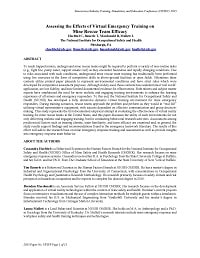Mining Publication: Assessing the Effects of Virtual Emergency Training on Mine Rescue Team Efficacy
Original creation date: November 2015
Authors: CL Hoebbel, TJ Bauerle, B Macdonald, LG Mallett
NIOSHTIC2 Number: 20048280
Proceeding of the 2015 Interservice/Industry Training, Simulation and Education Conference, November 30 - December 4, 2015, Orlando, Florida. Arlington, VA: National Training and Simulation Association (NTSA), paper no. 15119, 2015 Nov; :15119
To reach trapped miners, underground mine rescue teams might be required to perform a variety of non-routine tasks (e.g., fight fire, pump water, support unsafe roof) as they encounter hazardous and rapidly changing conditions. Due to risks associated with such conditions, underground mine rescue team training has traditionally been performed using live exercises in the form of competitive drills in above-ground facilities or open fields. Oftentimes these contests utilize printed paper placards to represent environmental conditions and have strict rules which were developed for comparative assessment purposes. Although widely used, these contests have undetermined 'real world' application, are low fidelity, and have limited documented evidence for effectiveness. Both miners and subject matter experts have emphasized the need for more realistic and engaging training environments to enhance the learning experience of all miners and emergency responders. To this end, the National Institute for Occupational Safety and Health (NIOSH) has developed a fully immersive dynamic virtual training environment for mine emergency responders. During training scenarios, rescue teams approach the problem and perform as they would in "real life" utilizing virtual representative equipment, with success dependent on effective communication and group decision-making. This study represents the first documented empirical attempt at evaluating the effectiveness of virtual reality training for mine rescue teams in the United States, and this paper discusses the utility of such environments for not only delivering realistic and engaging training, but for conducting behavioral research activities. Associations among psychosocial factors such as training climate, team familiarity, and team efficacy are examined and, in general, the study results support findings and recommendations found in the emergency teamwork literature. The results of this effort will add to the research base on mine emergency response training and assessment as well as provide insights into emergency response team behavior.

NIOSHTIC2 Number: 20048280
Proceeding of the 2015 Interservice/Industry Training, Simulation and Education Conference, November 30 - December 4, 2015, Orlando, Florida. Arlington, VA: National Training and Simulation Association (NTSA), paper no. 15119, 2015 Nov; :15119
- Drill Rig Incident
- Emergency Escape and Refuge Alternatives
- Evaluation of VR Mine Rescue Training Platform
- Exploring Virtual Mental Practice in Maintenance Task Training
- How to Operate a Refuge Chamber: A Quick Start Guide
- I Can't Get Enough Air! Proper Self-contained Self-rescuer Usage
- Mine Emergency Response Command Center Training Using Computer Simulation
- Mine Rescue Training Facility Inventory - Compendium of Ideas to Improve US Coal Mine Rescue Training
- New Simulated Gas Detector Offers Realistic Training for Mine Rescue Teams
- Radio 101: Operating Two-Way Radios Every Day and in Emergencies